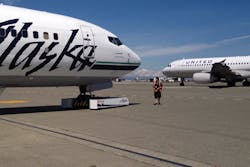Kersten Eckert, aviation enthusiast and the first owner of a Cirrus aircraft, figured there must be a better way to simply move his plane out of its hangar.
Eckert started selling audio equipment for the automotive market in the late-1970s, but he started out in the aviation industry serving as an aircraft mechanic apprentice and later qualifying as an aircraft electronics engineer.
However, his hobby remained flying, which seemed to him to come with a frustrating amount of time spent stuck on the ground. To get going, Eckert always had to make sure that he or someone else was onboard to apply the brakes if needed. Then, a few other people were needed to keep their eyes on the wings and tail to make sure the aircraft didn’t come down with a case of “hangar rash.” And if his plane was parked all the way in the back, well, maybe, he needed a different hobby, altogether.
So with the help of two other colleagues, Eckert set out to find a better way.
After being in development for around five years, the first Mototok tugs hit the market in 2008 and offered new technological solutions to many well-known technical problems.
Essentially, what the company developed is a battery-powered, remote-controlled wheeled platform that captures and lifts the nosegear of most any airplane or helicopter. With the unit, a single person could now easily maintain an all-round view of the aircraft and stop the movement of the aircraft on a dime. Nose wheels are easily picked up using a "one-click function" that takes only 15 seconds with the process hands-free with no straps or winches. While the tugs come in different models, one tug can handle a variety of aircraft up to its maximum load capacity since the unit automatically adjusts to various nosewheel sizes.
From there, powerful electric motors, emission-free and perfect for inside a hangar, driven by maintenance-free batteries with high cycle capability are regulated and controlled by two microprocessors. High torque ensures smooth acceleration throughout, but particularly at the start of the tow. Precise controls and the design of the tug allow the tug to pivot without moving laterally. As a result, both turning the nosegear and moving the aircraft are two completely different movements.
Various models are available with nosewheel towing capabilities ranging from 4,409 pounds to 22,046 pounds (maximum towing capacities of 61,729 to 209,439 pounds, respectively.) The company says the batteries will provide enough power for several days between charges, depending on workload. Most tugs have 12V or 24/28V ground-power connections.
“It was a completely new concept when it came out,” says Paul Acri, sales manager, Mototok America. “If you look at other tractors, they’re all fine and certainly get your aircraft out of the hangar and down the taxiway. But I think we offer a high-tech solution at a reasonable price that does a better job of safeguarding the aircraft.”
While all the tugs are designed to accept planes both from the front and from the back, the tugs might be best put through their paces when the equipment is attached from the back.
Because the tug can clamp onto the nosegear from the rear, there is no need to leave an exit space for the tug in the front of the aircraft. As a result of a low-height, compact design and the remote control, the tug’s biggest advantage is its ability to maneuver an aircraft’s nose, tail or wing to just a few millimeters away from a either a hangar wall or the next aircraft. “Snail” mode allows the operator to safely move the plane to its parking space. Once the tug pushes the plane to where it needs to be, the operator can simply back the tug away from the aircraft. The company says the tug can increase the parking space in a typical hangar by 40 percent.
Mototok equipment are used by FBOs, MROs, military, aircraft manufacturers and personal aircraft operators around the world.
The company offers a full range of for almost all aircraft:
- SPACER: Aircraft up to 80 tons.
- TWIN: Aircraft and wheeled helicopters up to 50 tons.
- M-SERIES: Aircraft and wheeled helicopters up to 28 tons.
- HELIMO: Skidded helicopters up to 5 tons.

